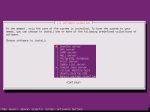In this article, I’m going to show you how I installed Alfresco Community 4 on a plain Ubuntu 12.04 server. We’ll be installing this entirely from the command line, without the assistance (complication?) of a GUI. I’m assuming you have a server ready, else get an Ubuntu server using this page.
Second, install Java. Now, this part is a little difficult, since Oracle doesn’t have a means of easily downloading the necessary tar file without jumping through GUI hoops. The way I did it was to use a GUI-based workstation to surf over to the download page, select the JDK download page, give away various legal rights, download it, then put it somewhere where I could wget it onto the above, pristine Ubuntu server. Once you have your grubby paws on it, uncompress it and move the resultant folder into /usr/lib/jvm. Now, if you installed from a virginal, minimal Ubuntu server, as we got from the previous guide, you don’t need to do much else. Other tutorials may have you purging OpenJDK before you take the steps below, or set environmental variables afterwards. This should not be necessary.
$ wget http://shoved.it.here/jdk-7u5-linux-x64.tar.gz $ tar -xvzf jdk-7u5-linux-x64.tar.gz $ sudo mkdir /usr/lib/jvm $ sudo mv jdk1.7.0_05 /usr/lib/jvm/jdk1.7.0 $ sudo update-alternatives --install /usr/bin/javac javac /usr/lib/jvm/jdk1.7.0/bin/javac 1 update-alternatives: using /usr/lib/jvm/jdk1.7.0/bin/javac to provide /usr/bin/javac (javac) in auto mode. $ sudo update-alternatives --install "/usr/bin/java" "java" "/usr/lib/jvm/jdk1.7.0/bin/java" 1 update-alternatives: using /usr/lib/jvm/jdk1.7.0/bin/java to provide /usr/bin/java (java) in auto mode. $ java -version java version "1.7.0_05" Java(TM) SE Runtime Environment (build 1.7.0_05-b05) Java HotSpot(TM) 64-Bit Server VM (build 23.1-b03, mixed mode)
If installation went as planned, you should see the last message when running the JVM to get its version. Next up is some accessory software. First, for our database, we will use the excellent PostgreSQL database. We will also install ImageMagick (for image manipulation), FFMPEG (for transforming video), LibreOffice (for the embedded document engine) and SWFTools (for the pdf2swf utility and previewing PDF files). Installing the last two are a bit tricky, as we have to setup a couple of PPAs to get this to work, which itself requires installing the ability to add PPAs (thus requiring python-software-properties)!
$ sudo apt-get install python-software-properties $ sudo add-apt-repository ppa:guilhem-fr/swftools $ sudo add-apt-repository ppa:libreoffice/ppa $ sudo apt-get update $ sudo apt-get install postgresql imagemagick ffmpeg swftools libreoffice
Alfresco is a Java-based web application, and needs a Java webserver to run it. The standard is Tomcat. So let’s install and configure that. While you are at it, install the Apache Native Libraries for a little oomph.
$ sudo apt-get install tomcat7 $ sudo service tomcat7 stop $ sudo apt-get install libtcnative-1 $ sudo service tomcat7 start * Starting Tomcat servlet engine tomcat7 [ OK ]
You can test your Tomcat server by pointing a browser to http://your.server.here:8080/ and you should see the standard Tomcat “It Works!” greeting page.
We are finally ready to install Alfresco. Download the zip file on your budding server, unzip it into a directory (we creatively called ours “alfresco”), and do the following:
$ unzip alfresco.zip -d alfresco $ sudo cp -r ~/alfresco/web-server/shared /var/lib/tomcat7 $ sudo cp -r ~/alfresco/web-server/webapps /var/lib/tomcat7 $ sudo cp -r ~/alfresco/web-server/lib /var/lib/tomcat7/shared/lib $ sudo cp -r ~/alfresco/bin /var/lib/tomcat7/bin $ sudo cp -r ~/alfresco/licenses /var/lib/tomcat7/licenses $ sudo cp -r ~/alfresco/README.txt /var/lib/tomcat7/README.txt $ sudo mv /var/lib/tomcat7/shared/classes/alfresco-global.properties.sample /var/lib/tomcat7/shared/classes/alfresco-global.properties $ sudo mv /var/lib/tomcat7/shared/classes/alfresco/web-extension/share-config-custom.xml.sample /var/lib/tomcat7/shared/classes/alfresco/web-extension/share-config-custom.xml
Now, we create a PostgreSQL database for Alfresco to use. If the last line executes without error, you’re doing fine.
$ sudo mkdir /opt/alfresco $ sudo chown -R tomcat7:tomcat7 /var/lib/tomcat7 /opt/alfresco $ sudo -u postgres createuser Enter name of role to add: alfresco Shall the new role be a superuser? (y/n) n Shall the new role be allowed to create databases? (y/n) n Shall the new role be allowed to create more new roles? (y/n) n $ sudo -u postgres createdb alfresco $ sudo -u postgres psql psql (9.1.4) Type "help" for help. postgres=# alter user alfresco with encrypted password '!QAZ1qaz'; ALTER ROLE postgres=# grant all privileges on database alfresco to alfresco; GRANT postgres=# \q $ psql -h localhost alfresco alfresco
You’ll have to now get dirty and delve into various settings and configurations. Here’s the list:
- /var/lib/tomcat7/conf/catalina.properties
shared.loader=${catalina.home}/shared/classes,${catalina.home}/shared/*.jar,/var/lib/tomcat7/shared/classes,/var/lib/tomcat7/shared/lib/*.jar- /var/lib/tomcat7/conf/catalina.properties
JAVA_HOME=/usr/lib/jvm/jdk1.7.0JAVA_OPTS="-Djava.awt.headless=true -Xmx768m -XX:+UseConcMarkSweepGC"JAVA_OPTS="${JAVA_OPTS} -XX:MaxPermSize=512m -Xms128m -Dalfresco.home=/opt/alfresco -Dcom.sun.management.jmxremote"JAVA_OPTS="${JAVA_OPTS} -XX:+CMSIncrementalMode"- /var/lib/tomcat7/shared/classes/alfresco-global.properties
- Change all settings to match your setup.
- /etc/postgresql/9.1/main/pg_hba.conf
- If you want to allow different access. Check online for more help.
Now, from any browser, you can log in via http://your.server.here:8080/alfresco or http://your.server.here:8080/share and begin managing your content in an enterprisey way.


